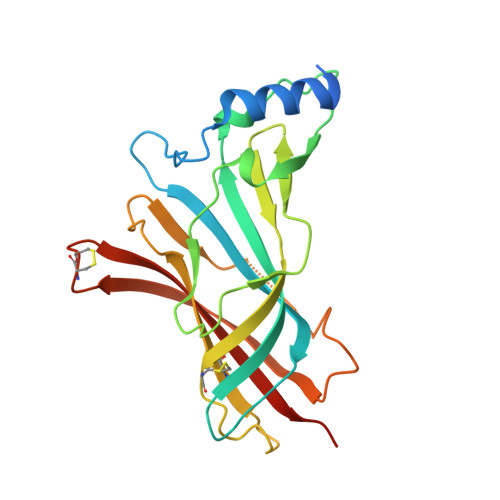Achbp Engineered to Mimic the Alpha4-Alpha4 Binding Pocket in Alpha4Beta2 Nicotinic Acetylcholine Receptors Reveals Interface Specific Interactions Important for Binding and Activity
Shahsavar, A., Ahring, P.K., Olsen, J.A., Krintel, C., Kastrup, J.S., Balle, T., Gajhede, M.(2015) Mol Pharmacol 88: 697
- PubMed: 26180047
- DOI: https://doi.org/10.1124/mol.115.098061
- Primary Citation of Related Structures:
4UM1, 4UM3 - PubMed Abstract:
Neuronal α4β2 nicotinic acetylcholine receptors are attractive drug targets for psychiatric and neurodegenerative disorders and smoking cessation aids. Recently, a third agonist binding site between two α4 subunits in the (α4)(3)(β2)(2) receptor subpopulation was discovered. In particular, three residues, H142, Q150, and T152, were demonstrated to be involved in the distinct pharmacology of the α4-α4 versus α4-β2 binding sites. To obtain insight into the three-dimensional structure of the α4-α4 binding site, a surrogate protein reproducing α4-α4 binding characteristics was constructed by introduction of three point mutations, R104H, L112Q, and M114T, into the binding pocket of Lymnaea stagnalis acetylcholine-binding protein (Ls-AChBP). Cocrystallization with two agonists possessing distinct pharmacologic profiles, NS3920 [1-(6-bromopyridin-3-yl)-1,4-diazepane] and NS3573 [1-(5-ethoxypyridin-3-yl)-1,4-diazepane], highlights the roles of the three residues in determining binding affinities and functional properties of ligands at the α4-α4 interface. Confirmed by mutational studies, our structures suggest a unique ligand-specific role of residue H142 on the α4 subunit. In the cocrystal structure of the mutated Ls-AChBP with the high-efficacy ligand NS3920, the corresponding histidine forms an intersubunit bridge that reinforces the ligand-mediated interactions between subunits. The structures further reveal that the binding site residues gain different and ligand-dependent interactions that could not be predicted based on wild-type Ls-AChBP structures in complex with the same agonists. The results show that an unprecedented correlation between binding in engineered AChBPs and functional receptors can be obtained and provide new opportunities for structure-based design of drugs targeting specific nicotinic acetylcholine receptor interfaces.
Organizational Affiliation:
Department of Drug Design and Pharmacology, Faculty of Health and Medical Sciences, University of Copenhagen, Copenhagen, Denmark (A.S., J.A.O., C.K., J.S.K., M.G.); Faculty of Pharmacy, University of Sydney, Sydney, New South Wales, Australia (P.K.A., J.A.O., T.B.); Saniona AB, Ballerup, Denmark (P.K.A.); and NeuroSearch A/S, Hellerup, Denmark (J.A.O.).



















